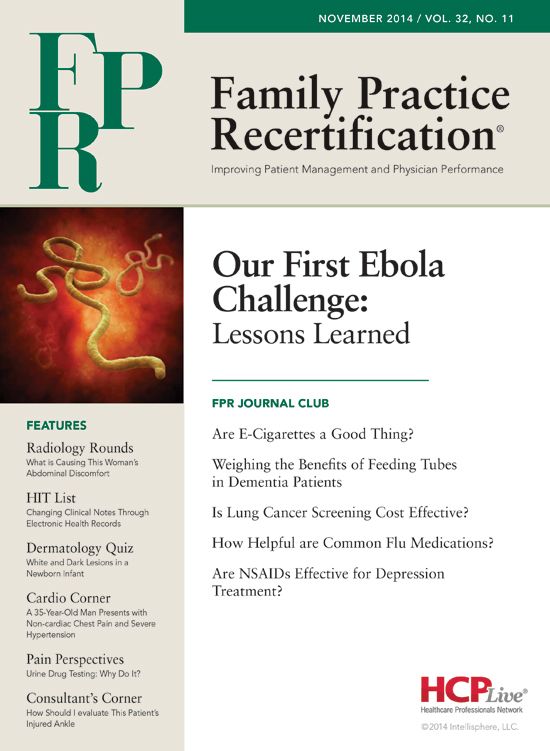Publication
Article
Family Practice Recertification
Is Lung Cancer Screening Cost Effective?
Author(s):
The National Lung Screening Trial, published in 2011, demonstrated that annual screening with low-dose computed tomography reduced lung cancer mortality by 20% among people aged 55-74 years. This data applied to people who had a smoking history of at least 30 pack-years and either continued to smoke or had quit within the last 15 years. This study examined the cost-effectiveness of this program.

Ronald Adler, MD
Review
“Cost Effectiveness of Lung Cancer Screening.” New England Journal of Medicine, 2014; 371:1793-802.
Introduction:
Lung cancer causes more deaths annually in the US than colorectal, breast, and prostate cancers combined.
The National Lung Screening Trial (NLST), published in 2011, demonstrated that annual screening with low-dose computed tomography (LDCT) reduced lung cancer mortality by 20% among people aged 55-74 years. This data applied to people who had a smoking history of at least 30 pack-years and either continued to smoke or had quit within the last 15 years.
This study examined the cost-effectiveness of this program.
Results and Outcomes:
As compared with no screening, LDCT performed annually for 3 years cost an additional $1,631 per person and provided an additional 0.0316 life years per person, though only 0.0201 Quality Adjusted Life Years (QALY) per person.
The study also looked at the incremental cost effectiveness ratios (ICER), which is the change in costs to incremental benefits of a therapeutic intervention. The ICER is a tool to determine the cost/benefit ratio across a variety of circumstances, disease states or treatments. In this study the ratios were were $52,000 per life-year gained and $81,000 per QALY. These figures varied widely in sub-group and sensitivity analyses. For example, the ICER was much lower for women, who came in at $46,000, compared to $147,000 for men per QALY gained. The same was also true for current smokers as women were measured at $43,000 versus men in the same category who were shown at $615,000 for former smokers per QALY gained.
Conclusion:
The authors conclude screening with LDCT for lung cancer as performed in the NLST costs less than $100,000 per QALY gained. They further noted that “the determination of whether screening performed outside the trial will be cost-effective will depend on exactly how screening is implemented.”
Discussion:
In December 2013, the US Preventive Services Task Force (USPSTF) endorsed LDCT for lung cancer screening as a grade B recommendation. Based on mathematical modeling, the USPSTF extended the eligibility criteria beyond the NLST participants to include individuals up to age 80.
While the Affordable Care Act requires private insurers to cover USPSTF grade B recommendations, Medicare is still considering whether to cover it, as their Advisory Committee stated “low confidence” in the applicability of the NLST results to the Medicare population.
Among other concerns, the committee noted that only 25% of NLST participants were at least 65-years-old and none were 75-years-old or older.
In November of 2014 Medicare issued a draft decision to cover the NLST eligibility criteria but did not extend the age range endorsed by the USPSTF. The draft was open for public comment and no final decision had been reached as of press time.
The American Academy of Family Physicians issued a statement that there is insufficient evidence to recommend screening. However, numerous other organizations, including the American Cancer Society, the American Association for Thoracic Surgery, and the American College of Chest Physicians have endorsed screening. Notably, those organizations supporting the recommendation have a vested financial interest in screening, and all groups called for a process of shared decision-making before proceeding to imaging. This implies that both clinicians and patients need to understand the projected benefits and harms associated with LDCT.
In this process the risks and benefits of the screening also need to be considered. The NLST determined a lung cancer mortality reduction of 20% with screenings. However, the absolute risk reduction was only 3 per 1000 people screened. This leaves the question of what happens to the other 997 screened people? Of those, the authors noted, 375 will have a false-positive LDCT, resulting in a need for other interventions, including additional imaging.
The average LDCT screening involves radiation doses 10-15 times higher than chest radiography. It has been estimated that for every 2500 people having 3 annual LDCTs, there will be one death from a cancer induced by the radiation exposure.
For those determined to need the invasive testing, 41 will have a biopsy for a benign nodule. Another 10 people will have a surgical procedure for a benign nodule, and 3 people will have a complication from an invasive procedure for a benign nodule.
There are 2 important caveats worth noting. The first concerns the appropriateness of extrapolating NLST results to the general population. The study was performed at 33 academic centers with highly-trained radiologists and multi-disciplinary teams. Selection criteria and clinical protocols were strictly followed. Failure to follow these in the real world may yield significantly different outcomes.
The second potential issue concerns the cost-effectiveness study above. The authors acknowledge that even “modest changes in our assumptions would greatly alter” the results. For example, they estimated the cost of screening to be $285 but did not account for the costs associated with patient counseling and follow-up. They wrote that “as the true cost of screening approaches $500, the cost becomes prohibitive.”
Sadly, the LDCT screening data did not result in any benefit in smoking cessation. While rational to think screening may inspire some to quit smoking, others may reason that they smoked for years without developing cancer, so why quit now?
If there is an “upside” to providing LDCT screening, it is the opportunity it presents for smoking cessation counseling. This should always be included in the pre-screening conversation with current smokers, and in the discussion of the screening result. Lung cancer is still more easily prevented than treated.
As further experience is gained with LDCT for lung cancer screening, there may be opportunities to improve the performance characteristics of the test through more refined stratification of the population at risk and more selective use of LDCT.(1) Until then, family physicians should be aware of how to counsel potential candidates for lung cancer screening:
A. The USPSTF eligibility criteria include people 55-80 years who had a smoking history of at least 30 pack-years and either continue to smoke or who quit within the last 15 years
B. The absolute mortality benefit of screening is 3 per 1000 people screened, but nearly 40% of people screened will experience false positive results, leading to a cascade of additional interventions and some data predicts that if screened for 3 years, 1 in 2,500 will die from a radiation induced disease;
C. Some groups who have endorsed this screening have a financial interest in it being applied;
D. Pre-test and post-test discussions must address smoking cessation for those patients who continue to smoke
References:
1. * Kovalchik SA, Tammemagi M, Berg CD, et al. Targeting of low-dose CT screening according to the risk of lung-cancer death. N Engl J Med. 2013;369(3):245-254.
About the Author
Ronald Adler, MD, FAAFP is Associate Professor of Family Medicine and Community Health at the University of Massachusetts Medical School, where he also serves as Director for Primary Care Practice Improvement through the Center for the Advancement of Primary Care.




